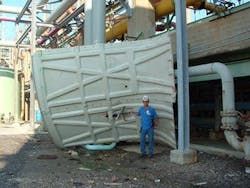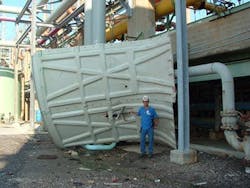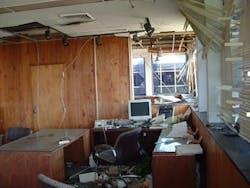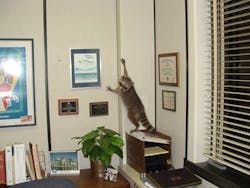No one can stop the hurricanes, tornadoes, floods and other severe events that Mother Nature throws our way. However, that doesn’t mean chemical plants shouldn’t prepare to cope with them with as little disruption as possible — to the environment, assets and the bottom line.
Last year, chemical facilities along the Gulf Coast endured Hurricanes Harvey, Irma and Maria, among others. Harvey, a Category 4 storm, alone caused $125 billion in damage, according to the National Hurricane Center. One notable example of a chemical plant impacted by Hurricane Harvey was Arkema’s facility in Crosby, Texas, where some chemicals required refrigeration to stay inert. When the storm disabled the cooling equipment, temperatures rose and the chemicals decomposed, leading to explosions. (See: “Ponder Hurricane Harvey’s Hard Knocks.”) Maria knocked out power on Puerto Rico and devastated roads and other infrastructure, severely impacting the many pharmaceutical plants there.
In addition, rogue snowstorms also hit the southern portion of the United States — causing significant problems for plants not used to dealing with substantial snowfall.
Common Error
If you think an extreme weather event is unlikely to happen at your plant, you’re not alone. According to a survey of senior financial executives at large U.S.-based companies with operations in Texas, Florida or Puerto Rico conducted by FM Global, Johnston, R.I., a mutual insurance company specializing in property risk management, 64% of the respondents said 2017’s hurricane season had an adverse impact on their operations. Of those impacted, 62% admitted they were “not completely prepared” to deal with the effects of the hurricanes. As a result, 68% of all respondents stated they will make changes to their risk-management strategy going forward.
“These candid admissions drive home a fundamental truth about catastrophe,” says Louis Gritzo, vice president and manager of research at FM Global. “People routinely fail to understand or acknowledge the magnitude of risk until they’ve experienced a fateful event.”
Also contributing to inadequate arrangements is imprecise terminology, he believes. “[B]eing in a “100-year flood” zone does not mean you have 99 years to plan. Rather, there’s a 1% chance of such a flood every year. Another reason for insufficient preparation is over-reliance on insurance, which cannot restore market share, brand equity and shareholder value lost to competitors. A third reason is denial of risk.”
Dr. Sam Mannan, director of the Mary Kay O’Connor Process Safety Center at Texas A & M University (and presenter of CP’s popular Process Safety webinar series), agrees that most plants aren’t prepared for weather extremes. “When you get to the point when you realize the design [of the plant] isn’t good enough, you can’t relocate. You have to retrofit — add pumps and redundant systems. Some have fallen short in doing that.
“You have to monitor for the weather — and when it hits you go into shutdown mode… But the problem is that you eventually have to start up again and that’s the source of many accidents. You don’t know what equipment has been impacted. You must do start-up tests. It’s a nasty ball of wax that comes into play,” notes Mannan.
He adds that extreme weather is a recent phenomenon. “If you look at the turn of the century from 20th to 21st, the number of named storms that have hit the U.S. has grown — Katrina, Rita, Harvey, Maria, Irma. These named storms have left an impact. And not much has been done to help plants prepare.”
Riding Out Rita
In 2005, Hurricane Rita, a Category 3 storm, barreled over the Louisiana/Texas border and wreaked havoc on PPG Industries’ Lake Charles, La., chemicals complex. The plant got through the worst of the storm thanks to three “Ps”: preparation, perseverance and powering up again.
“The plant must understand interactions and limitations with suppliers, customers and the community when they have been threatened or struck by a hurricane,” notes Roy E. Sanders, who was PPG’s compliance team leader at the time, in a May 2007 article in the Journal of Hazardous Materials.
Many things went well for PPG. The chemical complex was shut down and secured in time, all critical safety and environmental systems performed as designed, and ride-out crews included employees with the right skill sets to ensure proper inspection of all critical equipment and systems.
Some things like the food supply could have been handled better, though. “In the beginning, workers went home and cleared out their [non-working] freezers so we ate really well — shrimp and steak,” says Sanders. However, by the end of the five or six days that the site was without power, food rations got tight, he notes. In hindsight, the plant probably should have thought about stocking emergency ready-to-eat meals and a larger water supply when preparing for the storm.
“Not having bedding was tough, too. We had to sleep on the floor. And most of these buildings are not set up to get outside air. In the deep south, the humidity is unbearable and I think God punished those of us who stayed behind by sending a plague of mosquitoes,” jokes Sanders. Another thing to consider when you are faced with extreme weather is the local wildlife, he counsels. “They get displaced, too, and show up in spots you wouldn’t expect them to. We had a raccoon roaming around in the plant.”
The Role Of Social Media
Social media isn’t just for videos showing cute cats (or raccoons in manufacturing plants). In some instances, it is the first line of communication when disaster strikes. That can be a good and bad thing, notes Dana Cooper, president of Stevensville, Mich.-based Cooper Hayes, a business-performance-improvement consulting firm specializing in sustainability and process safety. Last year, she advised attendees at the Society of Chemical Manufacturers & Affiliates annual National Safety Symposium to include a social media strategy as part of a company’s crisis management plan.
“It’s not just you sharing the news about your company,” says Cooper, who previously worked at Fairmount Santrol, a resin manufacturer, and Ashland Chemical. “Now you can be tagged in news coverage. Be proactive with a plan, then be defensive about what is out there that you can’t control.
“Ten years ago, you didn’t see drone images of flooded-out facilities. There is more information at our fingertips and your every move could be captured in a video. How do you react to that?”
Cooper suggests a company should strive to be the first to put out information and do so in a positive manner. Then, it should monitor what is being said about the company on social media. “You have to monitor, bottom line,” stresses Cooper. “You need to know who is going to monitor and you need to have a policy on what, when, where and how information will be shared [via social media].”
Social media also introduces a scare factor. In the past, only those directly impacted by extreme weather saw the damage. Now videos and photos let the whole world see what’s going on. According to Cooper, that’s when customers start to panic.
“Use social media to talk to people who aren’t in the affected area but will be impacted by the events,” she counsels. “Arkema said they updated their contingency plans but did their customers? Were their customers able to get materials during the shutdown?”
Mitigate The Risks
FM Global has a library of property loss prevention data sheets on everything from cooling towers to wind design. You can access the full library here. Here are highlights of two of these data sheets related to emergency response.
Know emergency response strengths and weaknesses. It’s important to size up factors that will help or hinder efforts. In particular, check:
- What fire protection is provided? Is it in service?
- What processing or storage hazards exist?
- What type of natural hazards could affect the site (e.g., floods, hail storms, windstorms from hurricanes, tornadoes or typhoons, earthquakes, snow or extreme cold)?
- What types resources are stockpiled and ready for use in case of a natural event (for example, availability of sump pumps, sandbags, portable barriers, emergency generators, portable pumps, etc.)?
- Are there staffing or equipment limitations?
- Have key personnel been educated and trained for the site-specific exposures?
- Are drills and periodic staff training provided?
- What communications equipment (2-way radios, intercoms, cell phones) are available?
- Are the locations of utility and process-supply shutoff valves clearly identified?
- What contractors will be needed and what’s the availability of their services?
- What regulations and guidelines of local, state and federal jurisdictions apply?
Execute drills and training. Each position needs its own set of training objectives. It’s important to establish drills with the on-site team and coordinate them with the local fire department and other outside agencies. Suggested frequencies are:
- Fire and explosion: quarterly education sessions and annual live fire training for firefighting teams and industrial fire brigades.
- Windstorm and winter hazards: prior to the time of the year when likely to occur.
- Earthquake: semi-annually to review actions to be taken.
About the Author
Traci Purdum
Editor-in-Chief
Traci Purdum, an award-winning business journalist with extensive experience covering manufacturing and management issues, is a graduate of the Kent State University School of Journalism and Mass Communication, Kent, Ohio, and an alumnus of the Wharton Seminar for Business Journalists, Wharton School of Business, University of Pennsylvania, Philadelphia.




